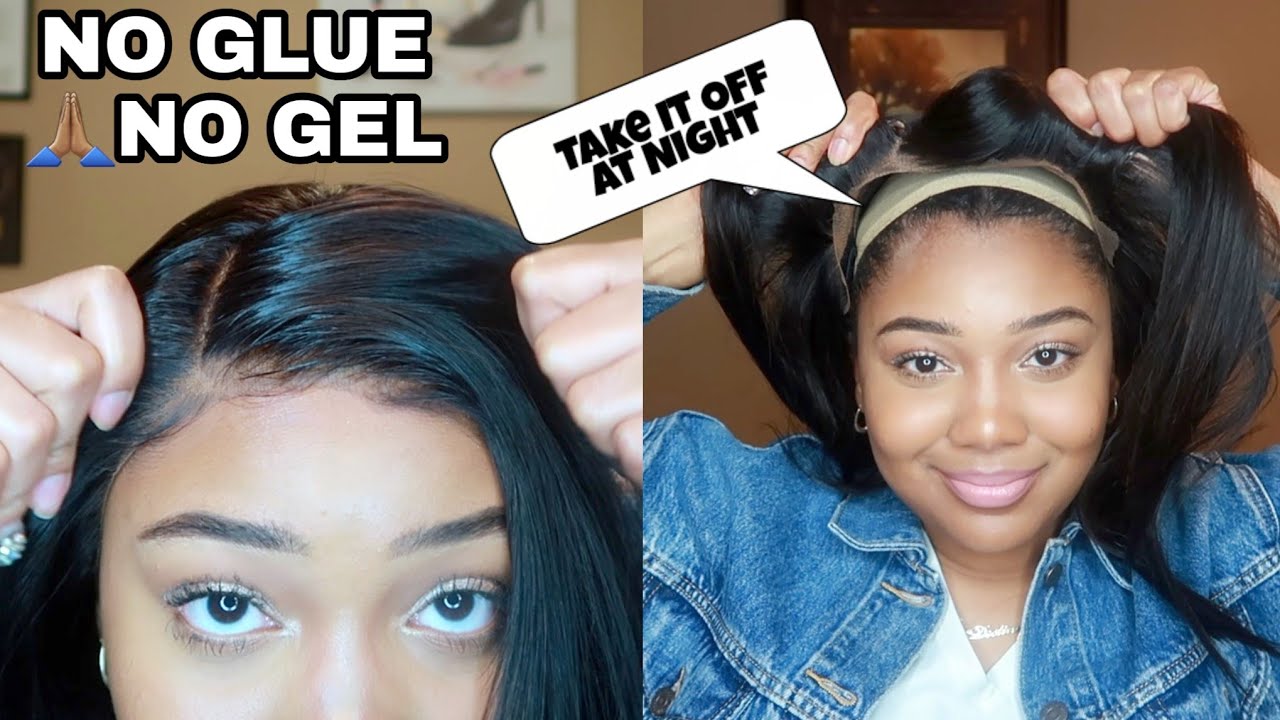Are you interested in trying out a human hair wig but not sure how to apply it without using glue? Well, you’re in luck! There are actually several methods you can use to secure your wig without the need for adhesive. In this article, we’ll explore some of these methods and guide you through the process step by step. By the end, you’ll have all the information you need to confidently wear a human hair wig without glue.
One popular method for applying a human hair wig without glue is using wig clips or combs. These small, discreet clips can be sewn onto the wig cap and then clipped onto your own hair for a secure fit. They are easy to use and provide a strong hold, ensuring that your wig stays in place all day long.
Another option is utilizing an adjustable strap or elastic band, often referred to as a wig grip or wig grip band. These bands can be worn underneath the wig cap and are adjustable to fit different head sizes. They provide a snug and secure fit, preventing the wig from slipping or sliding. Plus, they are comfortable to wear and won’t cause any discomfort.
Lastly, you can use double-sided wig tape or adhesive strips to secure your wig without glue. These tapes are specially designed for wig application and are typically hypoallergenic and skin-friendly. They offer a strong hold and are easy to remove without causing any damage to your natural hair or the wig itself.
In this article, we’ve covered just a few of the methods you can use to apply a human hair wig without glue. Each method has its own benefits and may work better for different individuals depending on their preferences and needs. By exploring these options further, you’ll be able to find the best method that suits you and allows you to confidently wear your human hair wig without the need for glue. Applying a human hair wig without glue offers several benefits, including increased comfort and ease of use, no damage to your natural hair, and added flexibility and versatility. In this article, we will guide you through the process of preparing your natural hair and wig, securing the wig without glue, applying the wig on your head, styling and blending the wig, and caring for the wig. We will also discuss the pros and cons of applying a human hair wig without glue, as well as other methods for securing a wig without glue. Additionally, we will touch on different wig application techniques and offer tips for maintaining and touching up your wig. By the end of this article, you will have all the information you need to confidently apply a human hair wig without the use of glue.
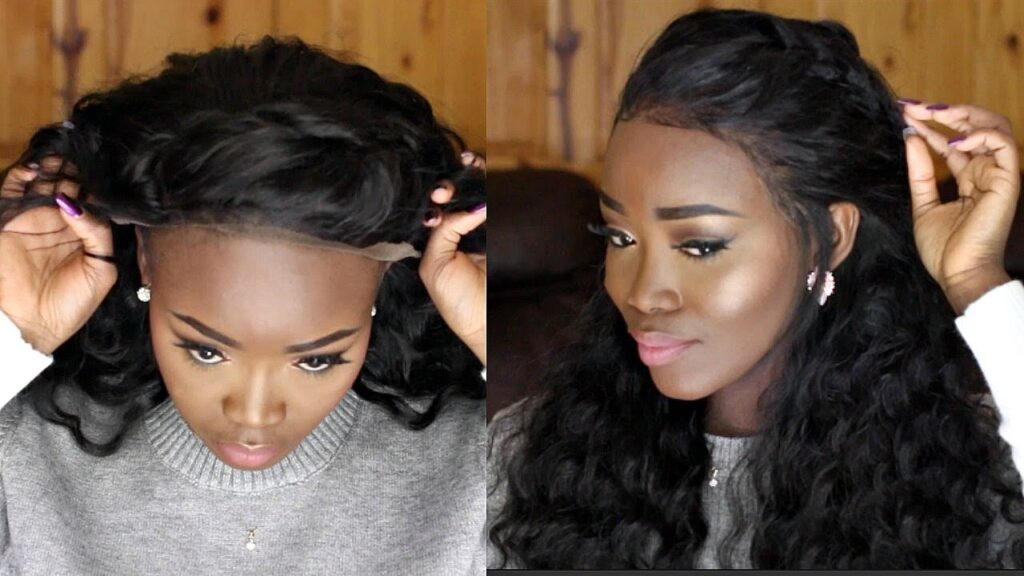
Benefits of Applying a Human Hair Wig Without Glue
Comfort and Ease of Use
One of the primary benefits of applying a human hair wig without glue is the increased comfort and ease of use. Glue can often be messy and time-consuming to apply and remove, and it may leave residue on both your scalp and the wig cap. By opting for a glueless application method, you eliminate the need for glue and can enjoy a more comfortable and convenient experience when wearing your wig.
No Damage to Natural Hair
Another advantage of applying a human hair wig without glue is that it eliminates the risk of damage to your natural hair. Glue can potentially cause breakage, thinning, or even bald patches if not applied or removed properly. By avoiding glue, you can maintain the health and integrity of your natural hair while still enjoying the benefits of wearing a wig.
Flexibility and Versatility
Applying a human hair wig without glue offers greater flexibility and versatility. Glueless wig applications allow you to easily switch between different wigs or remove your wig whenever desired. This flexibility allows for more variety in your hairstyles and lets you customize your look to suit your mood or occasion. It also makes it easier to care for both your natural hair and the wig itself.
Preparing Your Natural Hair and Wig
Before applying a human hair wig without glue, it’s important to properly prepare both your natural hair and the wig. This will ensure a secure and comfortable fit, as well as enhance the overall appearance of the wig when blended with your natural hair.
Wash and Condition Your Natural Hair
Start by washing and conditioning your natural hair to ensure it is clean and nourished. Use a gentle shampoo and a moisturizing conditioner suitable for your hair type. This step helps to remove any product buildup or excess oils from your natural hair, promoting a healthier scalp and preventing any unpleasant odors when wearing the wig.
Prepare Your Wig
Next, prepare your wig by gently combing or brushing it to remove any tangles or knots. If the wig has been previously worn, you may want to wash and condition it as well, following the manufacturer’s instructions. This step helps to refresh the wig and ensure it is clean and ready for application.

Securing the Wig Without Glue
Once your natural hair and wig are prepared, you can begin securing the wig without glue. There are several methods you can use to achieve a secure fit, including wig clips and double-sided tape.
Using Wig Clips
Wig clips are small metal or plastic clips that can be sewn onto the wig cap to secure it in place. To use wig clips, first determine where you want to position them on the wig cap. Then, sew the clips onto the cap, making sure they are evenly spaced and securely attached. When you’re ready to wear the wig, simply open the clips, position the wig on your head, and snap the clips closed to secure the wig in place. Wig clips offer a secure hold and can be easily adjusted or removed as needed.
Applying Double-Sided Tape
Another method for securing a wig without glue is by using double-sided tape. This tape is specifically designed for use with wigs and provides a strong hold without damaging your natural hair or the wig. To apply double-sided tape, cut the tape into small strips and carefully stick them along the edges of the wig cap. Then, remove the backing from the tape to expose the adhesive. Once the tape is in place, position the wig on your head and press it down firmly to ensure a secure hold. Double-sided tape offers a reliable hold and can be a preferred method for those who are sensitive to the weight or pressure of wig clips.
Applying the Wig on Your Head
With the wig secured in place, the next step is to properly position the wig on your scalp and adjust it to fit properly.
Positioning the Wig on Your Scalp
To position the wig on your scalp, start by matching the wig’s hairline with your natural hairline. Gently pull the wig over your head, starting from the front and working your way back. Once the wig is in place, adjust it to ensure the hairline appears natural and aligns with your forehead. Use a mirror to check the placement and make any necessary adjustments for a seamless look.
Adjusting the Wig to Fit Properly
After positioning the wig, it’s important to adjust it to fit properly. Most human hair wigs come with adjustable straps or hooks on the inside of the wig cap, allowing you to tighten or loosen the fit as needed. Use these straps or hooks to achieve a snug but comfortable fit. You can also use bobby pins or hair clips to secure any loose sections of the wig, especially around the temples and nape of the neck. Adjust the wig until it feels secure and comfortable, ensuring that it does not slide or shift when you move.
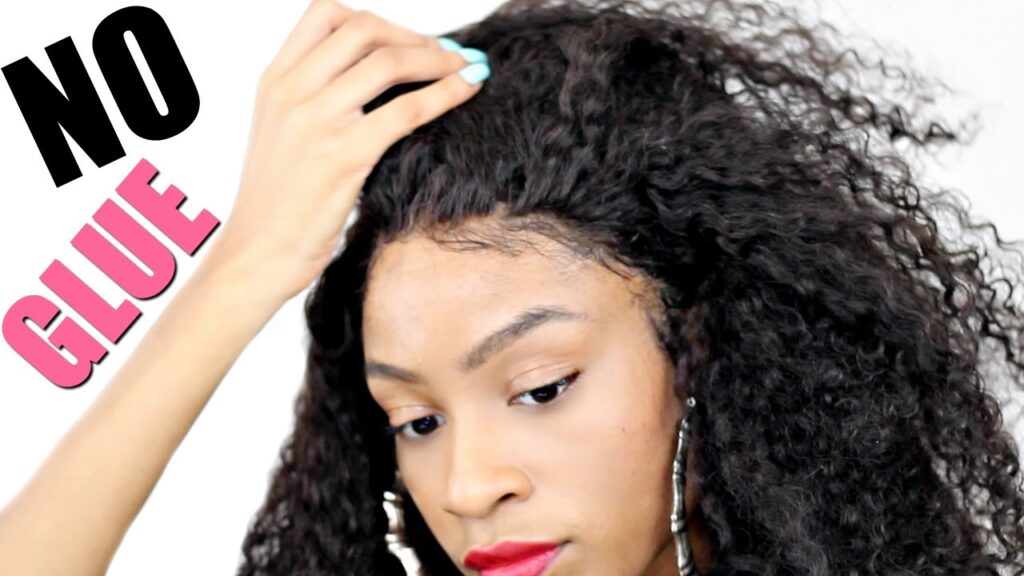
Styling and Blending the Wig
Once the wig is securely in place, you can style and blend it with your natural hair for a seamless look.
Trimming and Shaping the Wig
If necessary, you can trim or shape the wig to achieve your desired hairstyle. It’s best to seek professional help from a hairstylist experienced in working with wigs, as they can ensure that the wig is cut in a way that complements your face shape and looks natural. A professional stylist can also provide tips on how to style and maintain the wig to keep it looking its best.
Blending the Wig with Your Natural Hair
To achieve a natural appearance, it’s important to blend the wig with your natural hair. This can be done by using your fingers or a wide-toothed comb to gently tease and blend the edges of your natural hair with the wig’s hairline. You can also use styling products, such as hairspray or serum, to help smooth and blend the hair for a seamless transition. Additionally, choosing a wig that closely matches your natural hair color and texture will make blending easier and ensure a more natural look.
Caring for the Wig
To keep your human hair wig looking its best and ensure its longevity, it’s essential to care for it properly. This includes regular washing, conditioning, and proper storage when not in use.
Washing and Conditioning the Wig
Human hair wigs should be washed and conditioned regularly to remove any buildup or residue and keep the hair looking fresh and vibrant. Use a mild shampoo and conditioner specifically designed for human hair wigs. Gently massage the shampoo into the wig, working from root to tip, and rinse thoroughly. Apply the conditioner, focusing on the ends of the hair, and leave it in for a few minutes before rinsing. Avoid using hot water or vigorous rubbing, as this can cause tangling or damage to the hair. After washing, gently pat dry the wig with a towel and allow it to air-dry completely before styling or storing.
Storing the Wig Properly
When not wearing your wig, it’s important to store it properly to maintain its shape and prevent tangling or damage. Ideally, store your wig on a wig stand or mannequin head to help preserve its style and shape. If a stand or mannequin head is not available, you can carefully fold the wig and place it inside a breathable storage bag. Avoid storing the wig in direct sunlight or in humid areas, as this can cause damage to the hair. Regularly brushing or combing the wig to remove tangles and applying a small amount of leave-in conditioner can also help keep the hair smooth and prevent matting.
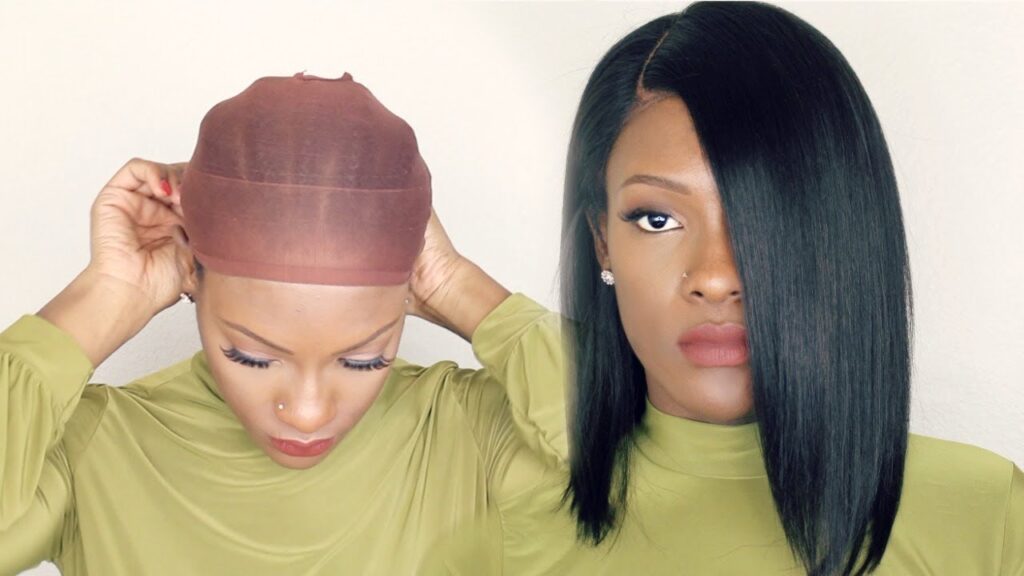
Pros and Cons of Applying a Human Hair Wig Without Glue
Like any hair accessory or styling method, there are both pros and cons to consider when applying a human hair wig without glue.
Pros: No Damage, Easy Application, Versatility
One of the main advantages of applying a human hair wig without glue is that it eliminates the risk of damage to your natural hair. It also offers a more comfortable and convenient experience, as there is no need to apply or remove glue. The overall application process is relatively simple and can be done at home with minimal tools or expertise. Additionally, the glueless method allows for greater versatility, as you can easily switch between different wigs or remove the wig whenever desired.
Cons: Less Secure, Limited Styling Options
One potential downside of applying a human hair wig without glue is that it may be less secure compared to a glued application. Depending on the chosen method, such as wig clips or double-sided tape, there is a slight risk of the wig shifting or moving throughout the day. This can be mitigated by choosing high-quality products and properly adjusting the wig to achieve a secure fit. Additionally, certain styling options, such as updos or styles requiring a tight hold, may be more challenging to achieve without the use of glue.
Other Methods to Secure a Wig Without Glue
If you prefer not to use glue, there are alternative methods to secure a wig without glue. Two popular options include using wig grips or bands and using bobby pins or hair clips.
Using Wig Grips or Bands
Wig grips or bands are accessories specifically designed to secure wigs without the need for glue. They are typically made of a non-slip material, such as silicone or velvet, and can be worn underneath the wig cap or directly on the scalp. The grips or bands provide added security by keeping the wig in place and preventing it from slipping or shifting. They are adjustable and can accommodate different head sizes and wig styles.
Using Bobby Pins or Hair Clips
Another method for securing a wig without glue is by using bobby pins or hair clips. These can be strategically placed along the inside of the wig cap or pinned into your natural hair to provide additional support and hold. When using bobby pins or hair clips, it’s essential to ensure they are properly hidden and do not show through the wig or cause discomfort. Experiment with different placement options and adjust the pins or clips until you achieve a secure and comfortable fit.
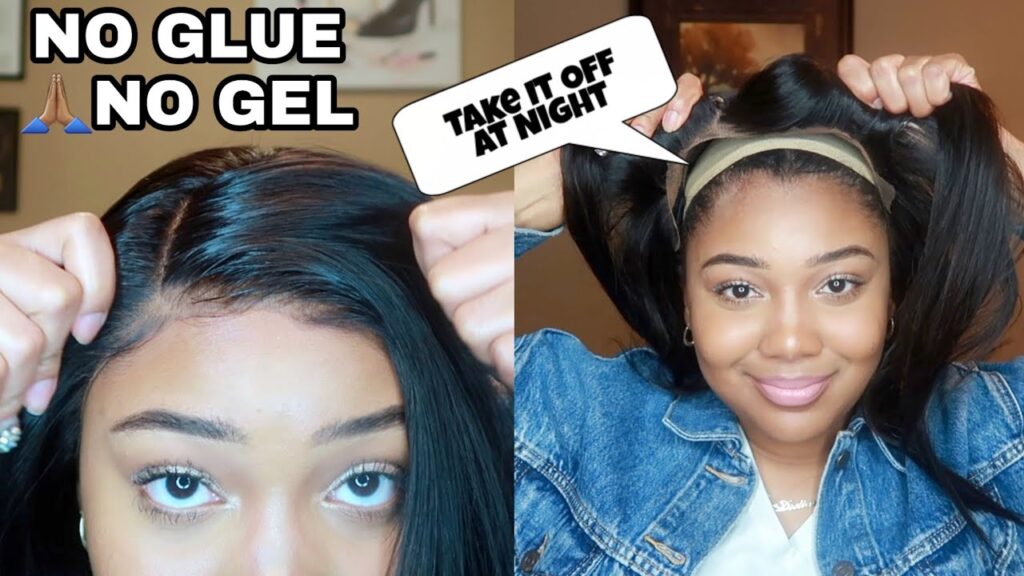
Different Wig Application Techniques
Aside from glueless methods, there are other wig application techniques to consider, such as sewing the wig in or using wig adhesives.
Sewing the Wig In
Sewing the wig in involves using a needle and thread to sew the wig onto a braided base or a wig cap. This method provides a secure and long-lasting hold, as the wig is essentially sewn into your natural hair. It is typically done by a professional or someone with experience in wig-making or hairstyling. Sewing the wig in requires time and precision but offers maximum security and stability. It can be a preferred option for those looking for a more permanent or semi-permanent wig installation.
Using Wig Adhesives
Wig adhesives, also known as wig glue or tape, are specifically formulated to secure wigs in place for an extended period. They provide a strong hold and can be used to attach the wig directly to your scalp or the wig cap. Wig adhesives come in different forms, including liquid glue, tape, or adhesive strips. It’s essential to choose a high-quality adhesive specifically designed for wigs and to follow the manufacturer’s instructions for application and removal. When using wig adhesives, it’s crucial to perform a patch test first to ensure you are not allergic to the product. It’s also important to properly remove the adhesive and cleanse your scalp to avoid any residue buildup or damage.
Maintaining and Touching Up the Wig
To keep your human hair wig looking its best, regular maintenance and occasional touch-ups are necessary.
Regular Cleaning and Conditioning
Regular cleaning and conditioning are crucial to maintain the appearance and integrity of your wig. Depending on how often you wear the wig and the amount of styling products used, you may need to wash it every few weeks or as needed. Be sure to use a shampoo and conditioner specifically formulated for human hair wigs, as regular hair products may contain harsh chemicals that can damage the hair. When washing the wig, be gentle and avoid rubbing or tangling the hair. After washing, allow the wig to air-dry completely before styling or storing.
In addition to regular cleaning, occasional deep conditioning treatments can help restore moisture and keep the hair soft and manageable. Apply a deep conditioning mask to the wig, focusing on the ends, and leave it in for the recommended amount of time. Rinse thoroughly and allow the wig to air-dry. Deep conditioning treatments can help revive the hair’s vitality and maintain its luster.
Restyling and Refreshing
Over time, the style of your wig may need to be refreshed or restyled. To do this, you can use heat styling tools, such as straighteners or curling irons, to create different looks. When using heat on your wig, it’s important to use a heat protectant spray and to avoid excessive heat that can damage the hair. Additionally, you can trim or reshape the wig’s layers or bangs to suit your desired style. If you’re unsure or uncomfortable with restyling the wig yourself, it’s best to seek professional help from a hairstylist who specializes in working with wigs.
Final Thoughts on Applying a Human Hair Wig Without Glue
Applying a human hair wig without glue offers numerous benefits, including increased comfort, no damage to your natural hair, and added flexibility and versatility. By following the steps outlined in this article, you can confidently apply a human hair wig without the use of glue. Remember to properly prepare your natural hair and wig, secure the wig using wig clips or double-sided tape, adjust the wig to fit properly, and style and blend the wig to achieve a natural look. It’s also essential to care for your wig by regularly washing and conditioning it and storing it properly when not in use. While there are pros and cons to applying a wig without glue, alternative methods such as wig grips or bands and bobby pins or hair clips can provide a secure hold. Ultimately, the choice of wig application method depends on personal preference and the desired level of security. By understanding different wig application techniques and maintenance tips, you can enjoy the benefits of wearing a human hair wig without glue and confidently enhance your style and confidence, customizing your look to suit your unique personality and needs.
